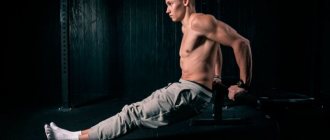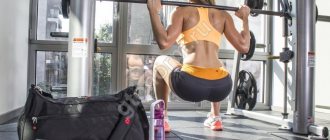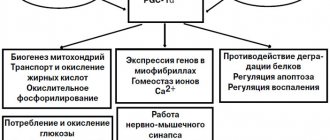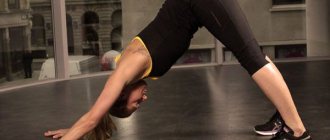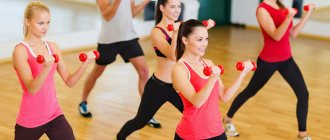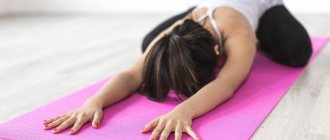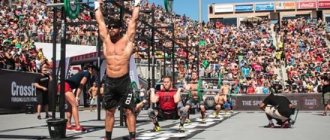Reverse push-ups are a great exercise for toning your triceps, stretching your back, and strengthening the back of your arms. The big advantage of the exercise is its variability in the direction of increasing the load - thus, push-ups from a bench in the back position are suitable for both women with poor physical fitness and experienced male athletes who want to diversify their training.
Reverse grip push-ups from a bench are so called because of the rear placement of the hands on the support. The athlete stands with his back to her, so his hands are located behind the body.
Variations
Reverse push-ups are done from a chair, bench, sofa - any support of suitable height (approximately up to mid-thigh);
- The easiest way to perform this push-up is with your knees bent when planting your feet. This option significantly reduces the overall load, so it is suitable for beginner athletes and people getting back into shape after a long break;
- If you straighten your legs, the task will become more difficult, but not to the maximum;
- Triceps bench push-ups can also be done with your feet placed on another bench of the same height. In order to master such a technique, the athlete will have to be well prepared;
- You can further increase the load by placing a heavy apparatus on your legs - a barbell disc or a kettlebell.
Options
All variations of elevated push-ups, in principle, are technically the same, but the most difficult ones will be those that involve the absence of fixation of the legs, for example, push-ups in TRX loops. This option will allow you to put more stress on the stabilizer muscles and minimize the body’s adaptation to the load.
As a variation, you should use this exercise, alternating the classic version with push-ups from a hill with your feet fixed on a hard, stable surface.
You can also do push-ups with your feet on a hill using:
- Changing the height , thereby increasing the angle. Then the emphasis will shift towards the front deltoid.
- Different positions of the hands , for example, narrow or, conversely, wide. Or even perform it with your hands positioned, as in “diamond” push-ups.
- Plyometric push-ups with legs elevated.
Pros and cons of the exercise
Reverse grip push-ups from the floor are especially appreciated by women with loose skin in the back of the arms. It allows you to strengthen the muscles and, accordingly, tighten the skin. In addition, reverse push-ups perfectly develop the triceps and contribute to the formation of a beautiful relief. By the way, in this exercise the target muscles work not only on the ascent, but also on the descent, that is, in both phases. Moreover, it is easy to perform at home, on the street, and in the gym. The execution technique is very simple - it is enough to grasp the correct algorithm once, and in the future there will be no problems.
Among the disadvantages, back push-ups with your back to the bench are unlikely to allow you to significantly increase the size of your arm muscles. For this purpose, a directed force load is required. Also, this type has many contraindications, including inflexible ligaments and joints (not prepared), past or current injuries to the shoulder and forearms. The shoulder joints receive the highest load, so athletes with an Achilles heel in this area should avoid the exercise.
Recommendations
This option should be performed after classic push-ups. This will minimize the chance of a shoulder injury, as the target muscles and ligaments will be prepared for the load.
The introduction of the exercise into the training program should be gradual, that is, there is no need to use complex execution options and weights. Also, at the beginning, you can perform push-ups not at full amplitude.
And also read: How to properly do push-ups with your fists → House push-ups for the shoulders → Hindu push-ups - what kind of technique is this?
Execution technique
Let's look at how to do reverse push-ups from the floor or bench - here's a step-by-step algorithm:
- Do a warm-up - warm up the target muscles, ligaments, joints;
- Stand with your back to the support, place your hands on it, fingers forward. The placement of the hands is shoulder width apart. Keep your back straight throughout all stages of the exercise. The head is raised, the gaze is directed forward. Place your legs on the opposite bench or on the floor; they can be bent or straightened. Press your heels into the surface;
- As you inhale, slowly lower yourself down, bending your elbows to a right angle. Do not spread your elbows to the sides;
- As you exhale, return to the starting position, without jerking, tensing your triceps.
- You can linger at the bottom point for a couple of seconds;
- Do 2-3 sets of 10 repetitions.
As you can see, reverse triceps push-ups from a bench, the execution technique, is extremely simple - the most important thing is to work slowly and efficiently.
Dependence of load on body inclination
In the classic version of push-ups, the legs and arms are on the floor, and during the movement the body takes a position parallel to the floor. Depending on how we place our hands, we can force the pectoral muscles (palms wide) or triceps (palms narrow) to work the most. But what happens if we raise our legs above our heads, or, conversely, put our hands on a stand?
Legs on support
When the legs are higher than the head, the weight of the body is mainly on the arms, and the arms are known to be smaller and weaker than the legs. Therefore, this type of push-up is a complicated variation of the classic exercise. You should include such push-ups in your training program if you have already mastered the basic push-ups to perfection.
In fact, the leg-up push-up is an inverted version of the bench press with a positive incline. At the same time, the upper part of the chest is emphasized. More specifically, the load distribution looks like this:
- pectoral muscles (emphasis on the upper part);
- deltoid muscles (anterior bundles);
- triceps;
- the abs and back muscles work statically.
The wider we place our hands, the more actively the chest works, especially the outer part; the narrower we place it, the greater the load on the triceps. With a narrow position of the arms, the load, which still goes to the chest, is shifted to their inner part.
Also, the higher you place your legs, the more your deltoids are activated. If we continue to lift our legs and get to the handstand push-up, it is actually a shoulder exercise.
The optimal inclination of the body for developing the upper chest is 30–45 degrees at the lowest point (chest near the floor). That is, in the starting position, it is enough to place your legs on a bench or fitball. With the latter option, the body is also actively working.
Hands on support
When we place our hands above our feet, that is, on a bench or stand, most of the body weight falls on our feet. And this is a completely natural state of affairs; every day we carry all our weight on our legs alone. Accordingly, this version of the exercise is much easier than legs above the head.
This type of push-up is well suited for beginners who still find the classic version of the exercise difficult.
Why do this easy thing, an experienced athlete will ask? The answer is simple - the exercise perfectly engages the lower part of the pectoral muscles. Therefore, if for some reason this area is lagging behind you, you can purposefully work on its development. So that life doesn’t seem like honey, we take weights in the form of a backpack or vest.
The load distribution looks like this:
- pectoral muscles (emphasis on the lower part);
- triceps;
- the muscles of the abs, back and legs experience static tension.
Common mistakes
Pay attention to our recommendations, this will help you avoid common mistakes:
- Breathe correctly—inhale down, exhale up. If you linger at the lowest point, hold your breath too;
- The back should not be arched - in this case, the load will be placed on the core muscles, not the arms;
- Elbows in the bending phase should remain perpendicular to the floor (do not spread them to the sides);
- Don't go too low, as this can dislocate or injure your shoulder joints. An angle of 90° is sufficient;
- Start with an adequate load, but don't stop there.
So, we have examined the technique of performing reverse push-ups from a bench from “A” to “Z”, and it’s time for practice. Have you already selected a training program?
Tips for increasing endurance
Up to 10 push-ups.
Master the exercise technique. Do one repetition with stops in the upper body position to make the muscles stronger.
11 – 30.
When the load increases, slow down the lowering phase of the body, and then lower it quickly. In this way, the muscles will begin to work even more actively.
31 – 50.
Now you're in the professional push-up zone. When your body is down, hold for a few seconds to further work the muscles.
50 or more.
To make the muscles bigger and stronger, the exercise needs to be complicated: do push-ups with clap or raise your legs up. Such a load will require strength and professionalism.
Sample program for beginners and experienced athletes
Beginner athletes are recommended to do reverse bench push-ups for the triceps at the beginning of their workout. Reverse push-ups require significant energy expenditure and are unlikely to be tough at the end, after strength approaches. Pre-do exercises to warm up your back and chest.
- Do 1 set of 15 repetitions with your legs bent at the knees;
- Perform 2 more sets of 10 repetitions without bending your legs;
- Rest between approaches – no more than 2 minutes;
- Perform the complex 2 times a week, each time increasing the number of repetitions by 3;
- When you feel ready, try placing a barbell plate on your feet (secure it well).
Experienced athletes can use reverse push-ups to stretch their upper body muscles and prepare their arms for more serious work.
- They are included either in the warm-up complex or transferred to the end of the lesson to consolidate the achieved results;
- Do push-ups with both arms and legs on the bench, using weights;
- Do 4-5 sets of 15-20 repetitions;
- Perform the complex 2-3 times a week.
Remember, reverse push-ups will give better results if you combine them with exercises for other arm muscles. In this case, the muscles will grow and develop evenly, which means that a beautiful relief will be achieved much earlier. Good luck in your training!
Advantages and disadvantages
Pros of the exercise:
- An effective exercise for developing the upper pectoral muscles.
- Can be performed anywhere, at home, on an outdoor sports ground, or in the gym.
- Suitable for both men and women.
- Has high potential if you use a weighting agent (for example, a fitness tape).
- A relevant exercise for all kinds of training purposes.
- Not traumatic.
Among the shortcomings, one can note only a point effect on the muscles, or rather only on the upper part of the chest. It is impossible to fully develop the pectoral muscles with such push-ups.
Knee push-ups for women
What are the benefits of knee push-ups for girls? As practice shows, many girls cannot push their own body weight off the floor even several times. This is female physiology, so in order to strengthen the arms and torso, it is necessary to perform a lead-in exercise.
The kneeling variation is an excellent solution that allows you to partially reduce the load of your own body weight and perform more repetitions.
Doing push-ups from your knees will allow you to prepare well technically, work out mistakes and understand all the features of the classic exercise.
Features of training for women and men
When developing programs for sports, women need to take into account the characteristics of their body and the specifics of muscle growth. The body is prone to storing fat
It is more difficult for them to increase muscle mass. This fact cannot be ruled out even among professional athletes.
The bulk of adipose tissue is located below the waist. The leg power of young women is 27% weaker than that of men. The shoulder girdle is inferior in endurance by 40-70%. The spine is longer, the limbs are shorter. The heart is smaller than a man's, so it contracts more often.
It takes the female body much more time to restore performance and well-being after heavy physical exertion, while men tolerate it much more easily.
It is more difficult for girls to achieve an increase in muscle mass in this area, even with intense strength training. The difference between the training program for the fairer sex is the technique of performing the exercises, the rhythm and number of repetitions for a specific muscle group.
Female muscles are composed of smooth muscles. It is characterized by:
- weak ability to increase;
- endurance;
- minimal damage.
Taking these features into account, the size of the load and the number of repetitions in the approaches are calculated. Girls need to perform exercises, increasing the number of repetitions by 30% from those performed by men, using a light load.
Don't miss the most popular article in the section: Body drying for girls. Training program, detailed nutrition menu for the month by day.
How to make push-ups easier
Those who are just starting to do push-ups may not be able to perform the classic (regular) type of push-ups on the first try. To simplify the task, you should first practice by using push-ups with emphasis on your knees. In this position, supporting your own body weight in your arms will be much easier. When the muscles get used to regular exercise and become sufficiently strong, you can move on to a more complex technique.
Gradually increase the number of repetitions, starting with 10-12 per set. Over time, perform more approaches (but not less than 3 initially). One of them should be worked with the usual technique, the rest - from the knees.
What muscles work during push-ups?
When performing this exercise, the muscles of the chest and triceps are mainly worked. The athlete can independently change the degree of load: the more the arms are spread, the more the pectoral muscles are loaded. Conversely, the smaller the distance between the palms, the more actively the triceps are worked.
Thus, when you do push-ups, the work includes:
- chest muscles (external and lower muscles);
- front deltoids and triceps;
- buttocks;
- press and lumbar area.
A well-chosen push-up program will allow you to train the above muscle groups without regularly visiting the gym. This exercise is ideal for practicing at home.
Why can't you put your head on the floor?
It is not surprising if you learned about such an exercise as handstand push-ups from sources related to CrossFit. In this discipline it is used very actively in training and competitions.
And everything would be fine, but there is one controversial point that should be paid attention to first. This is actually kipping
Surely you have noticed that when performing push-ups upside down, CrossFitter athletes stand on their heads during the last repetitions and push themselves up from this position by vigorously extending their legs. Then they lower themselves onto their heads again and push themselves out again using their legs
This is called kipping.
The number of repetitions in the exercise increases, but the damage caused to the cervical vertebrae is incomparable with any competitive awards. Therefore, if you are not a professional athlete and are not chasing awards in CrossFit, forget about kipping forever.
The fact is that the cervical vertebrae, unlike, for example, the lumbar vertebrae, are small and very fragile. They are like this not because nature overlooked something, but because the strength and size of the elements had to be sacrificed to ensure the mobility and flexibility of the structure. No wonder you can rotate your head, bend your neck in all directions, raise and lower your chin.
Of course, if at the bottom of the exercise you lightly touch your head to the floor, nothing bad will happen. But can you say with complete confidence that you always time the effort perfectly? Hit a little harder and you could end up with problems for life. Therefore, it is better to learn not to touch the floor with your head right away. In addition, many people have more or less pronounced curvature of the cervical spine. This means that when your head touches the floor, your spine will experience not only compression, but also shear load.
On topic: Gymnastics for a patient with legs
In general, since our goal is a beautiful, strong and healthy body, always follow the above recommendations.
Push-up workout
10-minute muscle pump
What:
This high-intensity, ten-minute, three-exercise circuit will flood your upper body muscles with blood to pump and completely fatigue your muscle fibers while keeping your heart rate up for both muscle-building and fat-loss effects.
How:
Do as many reps with your arms in a narrow position as you can, then rest for 20 seconds. Then do as many normal push-ups as possible and rest again for 20 seconds. Finally, do as many reps as possible with your arms in a wide stance and rest for 60 seconds. Repeat this pattern 4 times.
30 minute call
What:
This half-hour high-intensity workout will increase your body's muscular endurance by pumping up your muscles, resting, and then going through the fatigue process again.
How:
In the first and subsequent odd minutes, do ten normal push-ups and rest for the remainder of the minute. On even minutes, do ten reps of a different variation for your shoulders or triceps, and rest for the remainder of the minute. This way, you will do a total of 300 push-ups in just 30 minutes, which will help improve muscle strength and endurance. If ten repetitions seems easy to you, do 12-15 repetitions every minute.
Benefits of push-ups
The benefit of push-ups lies in the fact that the exercise uses the muscles of the whole body. Push-ups develop strength in the muscles of the chest, shoulders and arms. They provide a static load on the muscles of the legs, abdomen and buttocks.
They teach you how to do push-ups in the school gym. And for good reason.
The lying position strengthens the spine and longitudinal muscles of the back. Regular exercise trains the muscle fibers responsible for the flexibility of the spinal column. This is an excellent prevention of osteochondrosis.
Benefits for men
Men appreciate the benefits of push-ups from a young age. This exercise builds the muscles of the shoulder girdle. Repeated repetitions increase overall endurance.
Fist push-ups strengthen your hands
Which is very important for martial arts. Clapping push-ups improve coordination and sense of body control
Benefits for women
Why do girls need push-ups, what is useful about them? Bend your fingers.
First, it burns a lot of calories. The more complex the exercise, the more effective it is in getting rid of extra pounds.
Secondly, push-ups strengthen the pectoral muscles. The neckline area takes on an attractive shape.
Thirdly, the exercise removes sagging skin on the hands.
Fourthly, elasticity of the abdominal muscles and buttocks is obtained. Static load burns subcutaneous fat in these areas.

